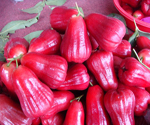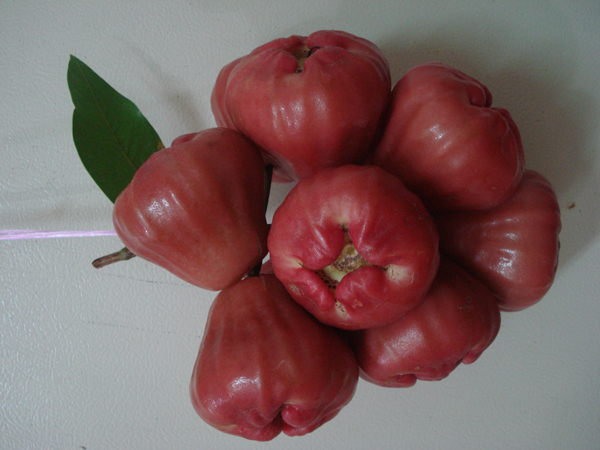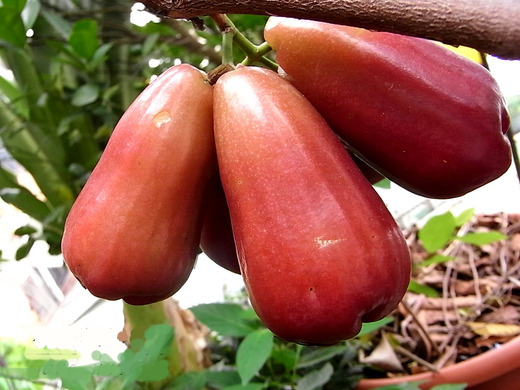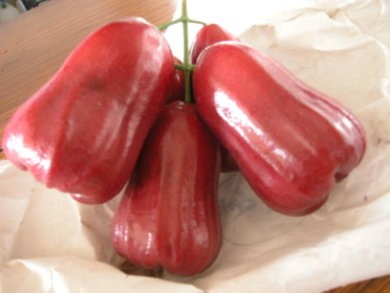
Syzygium samarangense(Wax Apple)
Syzygium samarangense is a tropical tree growing to 12 m tall, with evergreen leaves 10¨C25 cm long and 5¨C10 cm broad. The flowers are white, 2.5 cm diameter, with four petals and numerous stamens. The fruit is a bell-shaped, edible berry, with colors ranging from white, pale green, or green to red, purple, or crimson, to deep purple or even black, 4¨C6 cm long in wild plants. The flowers and resulting fruit are not limited to the axils of the leaves, and can appear on nearly any point on the surface of the trunk and branches.
Two of the most highly prized and sought-after wax apples in Taiwan are "black pearls", which are purplish-red, and the very rare green pearls, (only found in Xinshi District, Tainan), which are small and green . When ripe, the fruit will puff outwards, with a slight concavity in the middle of the underside of the "bell". Healthy wax apples have a light sheen to them. Despite its name, a ripe wax apple only resembles an apple on the outside in color. It does not taste like an apple, and it has neither the fragrance nor the density of an apple. Its flavor is similar to a snow pear, and the liquid-to-flesh ratio of the wax apple is comparable to a watermelon.
|

Unlike either apple or watermelon, the wax apple's flesh has a very loose weave. This mesh is edible, but flavorless. The color of its juice depends on the cultivar; it may be purple to entirely colorless. A number of cultivars with larger fruit have been selected. In general, the paler or darker the color, the sweeter it is. In Southeast Asia, the black ones are nicknamed "Black Pearl" or "Black Diamond", while the very pale greenish-white ones, called "Pearl", are among the highest priced ones in fruit markets. The fruit is often served uncut, but with the core removed, to preserve the unique bell-shaped presentation. |
Thub Thim Chan The bark is smooth, mottled green or reddish brown and peels off in thin flakes to reveal the attractive "bony" aspect of its trunk. The plant branches close to the ground and often produces suckers from roots near the base of the trunk. Guavas are primarily self-fruitful, although some strains seem to produce more fruit when cross-pollinated with another variety. Guavas can bloom throughout the year in mild-winter areas, but the heaviest bloom occurs with the onset of warm weather in the spring. |


The exact time can vary from year to year depending on weather. The chief pollinator of guavas is the honeybee. Guava fruits may be round, ovoid or pear-shaped, 2 - 4 inches long and are used in jam and juice. Small trees may be killed by temperatures of 27-28¡ãF, while older trees withstand short periods of 25-26¡ãF without much damage. However, if the top of trees are frozen, they usually sprout from the ground and are back in production in 2-3 years. |